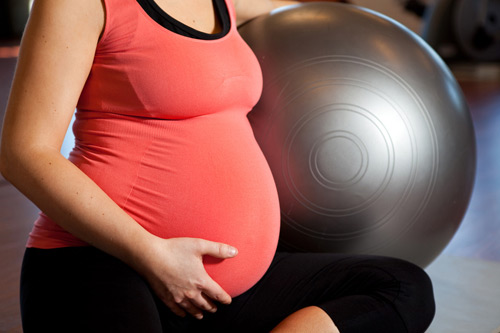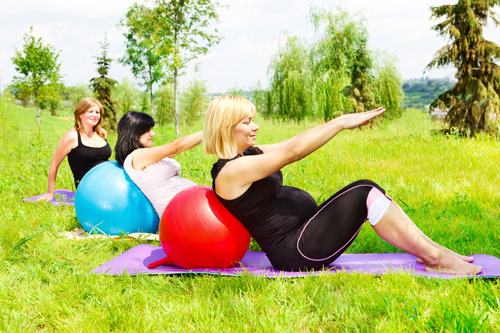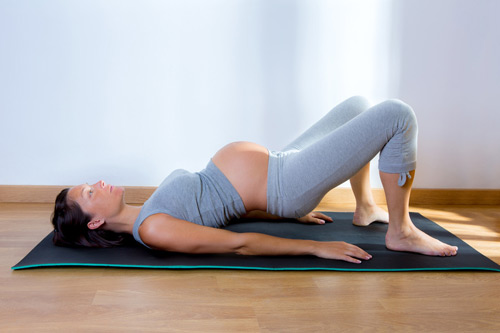Fitness

Congratulations on your pregnancy! Whether this is your first time expecting or your fifth pregnancy, your changing body will have an impact on how you normally work out. And if you haven't done much exercise in the past but you're motivated to start now, reading this article is a good first step!
Studies show that moderate to vigorous exercise - within carefully maintained parameters - is beneficial for both mom and baby. And more research points to the positive impact of exercise after the baby's born, including safe fat loss and less postpartum depression.
Pregnancy and Postpartum Exercise
Exercising while pregnant has numerous benefits:
- Improves well-being
- Gives you more energy
- Helps you sleep better (when sleeping is an option!)
- Lessens stress
- Eases aches and pains brought on by pregnancy and motherhood
- Minimizes a diastasis brought on by pregnancy
In addition to these benefits, perhaps the most important benefits of all are in preparing the mom to be for labor and delivery. Numerous studies have shown that women who exercise throughout their pregnancy experience shorter labor and delivery times with less surgical intervention.
Benefits of Prenatal Exercise for Your Baby
In addition to a shorter, less stressful labor and delivery (a bonus for both of you), prenatal exercise benefits your developing child:
- Provides a less stressful birthing experience
- Results in leaner babies (this has been linked to a lower risk of childhood obesity)
- Calms fetus
With all the benefits of exercise during pregnancy and the postpartum period, you'd think it'd be a time-tested tradition by now. But exercise for expecting women hasn't always been popular.

We've Come a Long Way, Baby
Our acceptance and knowledge of exercise during pregnancy has changed a lot in the last quarter of a century. In the 1970s, exercise for pregnant women was mostly frowned upon. Women were advised to be active only to the point of "breaking a sweat." Thankfully, times have changed.
In 2002, the American College of Obstetricians and Gynecologists (ACOG) came out with guidelines that advised pregnant women to do more than just break a sweat. These guidelines advocate real, modified-for-pregnancy exercise! (A few points from ACOG's guidelines are included later in this article.)
The growing popularity of prenatal and postpartum exercise is good news for you because it means there's plenty of evidence to show how you and your baby can benefit from exercise.
Exercise During Pregnancy
In addition to helping relieve the physical and emotional stresses of pregnancy, prenatal exercise "trains" you for the most important event of your pregnancy - the birth of your baby!
You'll be stronger during labor, which helps ensure a smoother, less traumatic delivery. After delivery, you'll be able to lift heavy loads - like a car seat, stroller and growing infant - with greater ease and less injury risk.
A note of caution is that during pregnancy all of the connective tissue in your body becomes more lax than normal due to the release of a hormone called relaxin. Elevated relaxin levels remain in your body for up to three months post-partum, so during your pregnancy and this post-partum period you will want to avoid deep joint flexion and extension to help prevent injury, as well as avoiding activities that require jumping or jarring motions or rapid changes in direction. If an activity becomes uncomfortable due to joint instability, modify or discontinue the activity.
Also, don't exercise vigorously in hot, humid weather or at all during an illness where you have a fever. Raising your core body temperature for extended periods of time, especially during the first six weeks of pregnancy, may potentially impact fetal development, although this has not been proven in humans.
Ready to start? Your first step is to get your doctor's clearance. After that, you can use the following pointers to help you get going.
Prenatal Exercise Prescription
Warming Up
The purpose of the warm-up is to prepare your body for exercise. As you warm up, you increase your core temperature and bring blood to the muscles which help reduce the risk of injury. The warm-up also acts as a rehearsal for the exercises you'll do during the workout itself.
Warm up for about 5 to 10 minutes. Start with small range-of-motion moves like toe taps, then progress to larger movements like gentle squats.

Strengthening Your Abdominals
Having strong abdominal muscles helps you push the baby out during delivery as well as minimizing the effects of a diastasis. Many abdominal exercises are safe during pregnancy. However, it's best to avoid twisting (bicycle) motions and exercises that place direct pressure on the abdominals.
You should also minimize lying on your back for extended periods after the first trimester to avoid creating hypotension. If you are lying on your back and feel light-headed or dizzy roll onto your side immediately to get the weight of the uterus off the main blood vessel (called the vena cava). Luckily, there are plenty of abdominal exercises you can safely do in positions other than lying on your back. These include: cat and cow, arm/leg extensions, plank (on knees) and bridging. Click the video link below for more training guidance.
Abdominal Exercise Video
Conditioning Your "Core"
Core training helps you strengthen your abdominals during pregnancy, but the "core" involves more than just your abs. The area of the body known as the core includes the muscles of the shoulders, chest, abdomen, back, hips and pelvis.
Your core stabilizes your skeletal structure and contributes to your overall health. The core is the body's power zone, and its center for initiating motion. Core muscles create a firm foundation for coordinated movement of the arms and legs, which will help you carry out everyday activities as a mom.
These Activities Include:
- Lifting a baby from her crib
- Carrying an infant or toddler
- Holding a child for breast- or bottle-feeding
- Pushing a stroller
- Bathing a child
Your fitness routine should incorporate core strengthening exercises that target your abdominals, upper- and mid-back, low back and butt.
Using your abdominal muscles during pregnancy by strengthening them is the most important thing you can do during your pregnancy.
Strong abdominal muscles will
- Prevent back problems
- Keep your diastasis smaller
- Help you push your baby out more effectively
- Help your abdominals get back in shape faster, as they have muscle memory from doing the exercises during pregnancy.
As you progress through pregnancy your core muscles, and in particular the rectus abdominus, are affected as your body makes room for your developing baby. The affect on your rectus abdominus, the outermost abdominal muscle that runs vertically from your public bones to your sternum, is called a diastasis recti.
Diastasis Recti
One very natural condition that occurs as your baby develops is that is a separation of the two halves of the rectus abdominus. This is a normal condition - it's estimated that 95% of new moms have a significant diastasis, and it's the reason women "show" sooner when they get pregnant again after their first baby.
When the muscle separates, it weakens the support system for the organs in the front and weakens the support system for the back causing low back problems.
The good news is that, while it shouldn't be ignored, diastasis recti is usually reversible with splinting and other appropriate exercises that enable you to engage the transverse muscles. Only rarely does this condition require corrective surgery.
To check yourself for a diastasis during and after pregnancy lay on your back with your knees bent, heels close to the buttocks; then put your fingers pointing down towards your pubic bone into your belly button. Press down and slowly lift your head. If you feel a hole in the middle as you lift your head you know that your have a diastasis. You can also check three inches below your belly button and three inches above your belly button. The fingers must be pointing down when you are checking yourself.
A diastasis can be fixed after pregnancy with an appropriate exercise regime. Even women who had their babies many years previously can perform appropriate exercises to help get this separation back together.
Getting the separation back together involves four things:
- Doing appropriate abdominal exercises every day
- Getting up and down correctly when getting in and out of bed
- Engaging the innermost abdominal muscle with all physical activity (sneezing, coughing, picking up baby, exercising, going to the bathroom, getting in and out of bed, getting up and out of a chair, etc.)
- Using a splint to make the starting position of the muscle closer together when doing abdominal exercises
It is important not to perform abdominal crunches with a diastasis as these will exacerbate the problem. Appropriate abdominal exercises work the rectus abdominus muscle from the middle. If you are not working this muscle from the middle and it is coming forward forcefully (as in a conventional abdominal crunch), then if you have a diastasis it will get larger and if you do not have one, you will create one on yourself.
Strengthening Your Pelvic Floor
Your pelvic floor muscles are shaped like a large hammock that stretch from side to side on the pelvis.
These muscles have multiple functions:
- Support the pelvic organs and abdominal contents
- Support the bladder and rectum and help control urinary and fecal continence
- They have a sexual function, helping to increase vaginal tone and sexual awareness
Kegel exercises strengthen your pelvic floor. Kegel exercises have been shown to be 50-80% effective in improving urinary continence. Since the pelvic floor muscles weaken during pregnancy and childbirth, doing them now and during the postpartum stage is crucial. Weak pelvic floor muscles may cause leakage of urine, also known as urinary stress incontinence, particularly when you sneeze, cough, run or laugh.
Doing Kegel exercises involves contracting your pelvic floor muscles. To get an idea of what a Kegel exercise should feel like, contract your muscles as if you were stopping the flow of urine and preventing a bowel movement at the same time. Please note, however, that stopping the flow of urine should NOT be used as an exercise in itself because it does not engage the entire pelvic floor hammock.
There are several variations of Kegel exercises you can do:
- The Basic Kegel - Squeeze and release the pelvic floor muscles. Start gradually and build up repetitions over time.
- Elevator Kegels - Visualize the muscles of your vagina as a building, with the base of your pelvic floor as the "lobby" and the top floor as your belly button. Raise the elevator slowly, tightening the pelvic floor muscles and visualizing the elevator moving from the bottom floor to the top. Hold briefly at the top floor, then lower the elevator, slowly relaxing your muscles from top to bottom.
- Sustained Kegels - Contract the pelvic floor muscles and hold for 10 seconds. Repeat 10 times. If you can't hold the contraction for this long initially, hold it for as long as you can. Work up to the 10-second hold as the pelvic muscles become stronger.
- Progressive Kegels - Squeeze briefly and hold the contraction for 5 seconds. Then squeeze harder and hold for another 5 seconds. Release completely and repeat 2 times.
As you develop strength in your pelvic muscles, you can incorporate Kegels into other exercises, such as squats, biceps curls and power walking.
Strengthening Your Upper Body
In addition to abdominal training, incorporate upper-body exercise into your fitness routine. Push-ups help you strengthen and tone your shoulders, biceps, triceps and chest - these are muscles you'll need to carry your baby and all his or her gear.
As your belly grows: You might start to feel that traditional push-ups become too difficult or awkward (usually around 6 months). If so, try side-lying push-ups like the ones shown in the video clip below.
Upper Body Exercise Video
Strengthening Your Lower Body
To work your lower body, try step-ups. You can do them at home using the bottom step of your staircase, a low park bench or a curb. Step-ups tone thighs and butt muscles, and they raise your heart rate for cardio, too.
As your belly grows: Your balance and weight distribution will change dramatically as your pregnancy advances. After about 6 months, do step-ups only on a low step or curb, or switch to squats with both feet on the floor.
Lower Body Exercise Video
Cardio
Getting cardio exercise during pregnancy is as important as strength training. To help you know what's best for you, read the following points from ACOG's guidelines for exercise in pregnancy and postpartum.
- Summary of 2002 ACOG Guidelines
- Exercise most or all days of the week.
- If you have an uncomplicated pregnancy, strive to accumulate 30 minutes of moderate exercise a day on most or all days of the week.
Participation in Most Activities is Safe
ACOG recommends that you evaluate the risk of contact injury or falling during any sport in which you would like to participate. Most activities are safe, but those that pose a risk of abdominal trauma - like horseback riding - should be avoided. Similarly, avoid scuba diving because the baby's immature circulatory system makes it more susceptible to decompression sickness.
Athletes Can Remain Active
It's considered safe for athletes to continue training at a low to moderate level during an uncomplicated pregnancy.
Exercise is Safe While Breastfeeding
Research shows that moderate exercise does not reduce a mother's milk supply.
Stretching
As with any fitness program, stretching is an important part of prenatal fitness, especially since your changing posture may shorten and tighten certain muscles. Incorporate stretches for the front of your shoulders, chest, hips and other major muscles into your exercise routine.
Monitoring Your Intensity
Whether you're warming up, doing cardio or strength training, make sure you stay within safe parameters for exercising during pregnancy. You can monitor how hard you're working out and ensure you stay within safe zones by using rate of perceived exertion, or RPE.
Rate of Perceived Exertion (RPE)
Match how you feel as you exercise to the physical responses listed below. You should be at about a 3 or a 4 during your warm-up and between a 5 and a 7 during cardio.
- I'm lying in bed, relaxed.
- I'm comfortable and barely exerting any effort.
- I'm comfortable, but I am beginning to feel warm and aware of my breathing.
- I'm sweating a little, but feel good and can carry on a conversation effortlessly.
- I'm just above comfortable, and I am sweating more. I can still talk easily.
- I can still talk, but I am becoming a little short on breath.
- I can still talk, but it is becoming more difficult. I'm sweating more.
- I'm not comfortable talking and would prefer to focus on my breathing. I can only keep this pace for a very short time.
- I feel that I may become ill if I continue at this pace.
- I am done.
What About Bed Rest?
What if something changes with your pregnancy that causes your doctor to put you on bed rest? There goes any chance you had at fitness, right? Not necessarily. You can still take measures to retain and even gain muscle strength and tone while on best rest.
Without muscle tone and strength, carrying a newborn baby and all the gear that goes along with your new bundle of joy can put excessive strain on your back. The result is an increased risk for injury and a slower recovery time from pregnancy, labor and delivery.
Be sure to consult your physician before attempting any activity while on bed rest. If all's OK, incorporate exercises like biceps curls and shoulder presses, and stretches for your legs and hips.
Your Fit Pregnancy and Beyond
Adding activity to your prenatal health plan helps ensure your pregnancy goes smoothly - from your first, second and third trimesters; to labor and delivery; to the postpartum stage and your new role as a mom. Enjoy the journey!
Article Provided by Baby Boot Camp

Kristen Horler, a Certified Personal Trainer and mother of two, launched Baby Boot Camp in San Francisco, California in 2001 after she could not find a fitness program that addressed the physical and logistical challenges of being a mom. Since that time, the company has expanded the program through franchising and licensing. Now more than 350 locations feature Baby Boot Camp classes.
Visit www.babybootcamp.com or call 888.990.BABY.
 PREGNANCY
PREGNANCY  GIVING BIRTH
GIVING BIRTH  BABY CARE
BABY CARE  HEALTH & SAFETY
HEALTH & SAFETY  FUN STUFF
FUN STUFF  FAMILY
FAMILY 